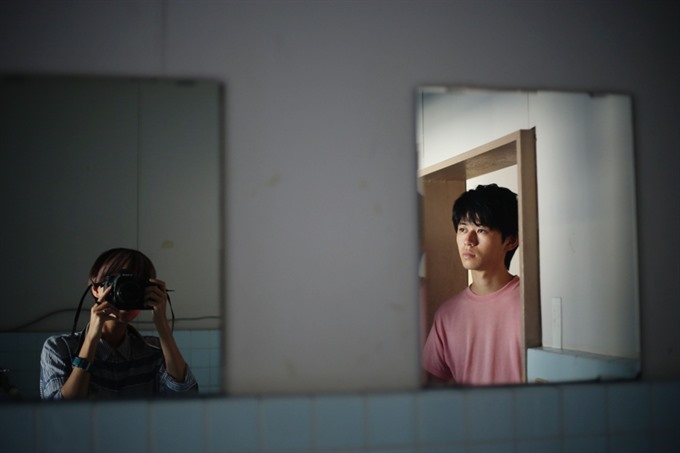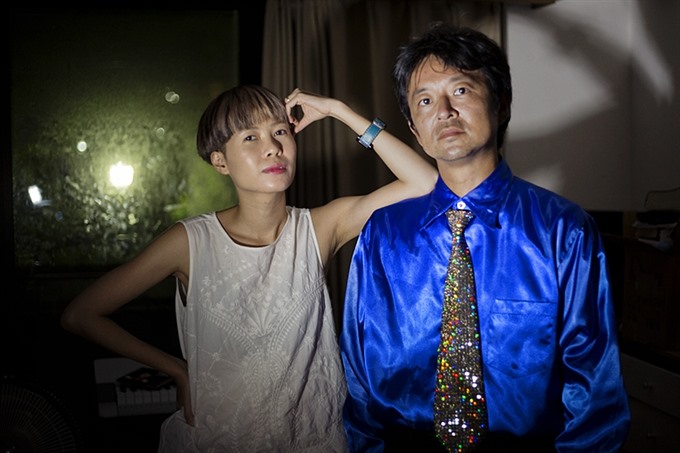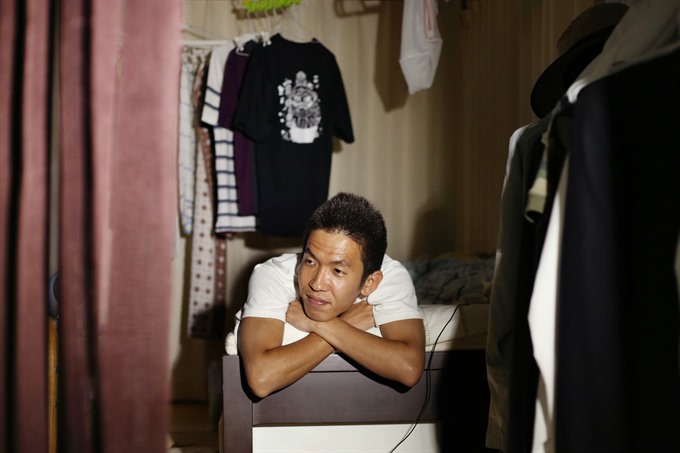 |
| Mirror mirror: Maika takes a photo of hikikomori Hiroki Chujo. — Photo courtesy of Maika |
Viet Nam News By Thúy Hằng
Maika Elan, the World Press Photo winner who was born in Hà Nội, has returned to Việt Nam after spending six months living in Kashiwa, Japan’s Chiba prefecture -- about 50km from Tokyo. The young photographer was pursuing her latest project -- accessing and photographing hikikomori, or young people who have withdrawn from society.
“Before going to Japan last summer, I spoke to a friend of mine who works as a journalist. From her, I learned of young Japanese men, who lock themselves in their rooms and refuse any outside contact. However, at that time, I had no idea that there was a term for this kind of behaviour,” said Maika (born Nguyễn Thanh Hải), who won the World Press Photo -- Contemporary Issues prize in 2012 for her photo collection titled Pink Choice, depicting Vietnamese gay and lesbian couples.
Thanks to the artist residence programme by the Japan Foundation Asia Centre, Maika arrived in Japan and decided to learn more about the hikikomori phenomenon prevalent amongst young Japanese men.
The term hikikomori, literally meaning “pulling in” or “withdrawal”, was first coined in 1998 by Japanese psychiatrist Tamaki Saito in his book Social Withdrawal: A Neverending Adolescence. In this book, Saito defined hikikomori as “those who withdraw entirely from society and stay in their own homes for more than six months, with onset by the latter half of their twenties, and for whom other psychiatric disorders do not better explain the primary causes of this condition.”
To begin her project, Maika offered to volunteer at New Start – a nonprofit organisation that helps people recover from hikikomori, and teaches them English.
“I wanted to observe hikikomori in person, and find a way of photographing them,” Maika explained.
However, it’s not easy to access a hikikomori – they often “run away” or stop showing up at New Start when Maika asks if she can take a photo.
After much effort, she met Oguri Ayako – a ‘rental sister’ who is hired to help hikikomori return to normal life and has 10 years of experience working with the young recluses.
For Maika, meeting Ayako was her “biggest success” while working at New Start because Ayako was able to help Maika get close to hikikomori.
Moreover, the more Maika learned about the hermits and the lives they led, the more she wanted to know about the connection between hikikomori and the rental sisters and brothers.
“It is a very important connection because the friends and families of hikikomori, or even hikikomori themselves, have to give up after years of trying to pull their loved ones out of the ‘cocoon’, those rental sisters and brothers, somehow manage to do that. In my eyes, they seem to have an extraordinary power that enables them to communicate with those who won’t talk to anyone else,” the 31-year-old photographer said.
Maika followed Ayako to meet her ‘customers’ three or four times every week. In Ayako’s company, the Vietnamese photographer began to get an insight into this special job.
Once hired, often by the parents of hikikomori, ’rental siblings’ will attempt to contact the reclusive people by sending them hand-written letters, which could annoy hikikomori.
“Rental sisters and brothers rarely receive prompt responses to their letters because hikikomori never read them, often tearing them up. However, the hired help won’t give up – they are very patient, maintaining a stream of letters for days, weeks, or even years, until the day a hikikomori, urged on by curiosity or desperation, would read the letter and reply,” said Maika.
“After a period of exchanging mail, the rental sisters and brothers will ask the hikikomori to talk on the phone, and then eventually for a one-on-one meeting at their home. Each rental sibling may have to spend one to two years persuading the hikikomori to emerge from their room or go to the New Start centre.”
Life of a hikikomori
Maika has met about 20 hikikomori during her stay in Japan. Contrary to her first impression of them as lazy and selfish, she was surprised to find a completely different personality.
“In my imagination, because they lock themselves in their room for long periods of time, I thought they would be apathetic and inactive. However, I was wrong. More than half of the hikikomori I met were very smart, active, and even sprightly. They simply chose to live a reclusive lifestyle and are satisfied with that decision,” said Maika.
During a talk about her project held recently at the Hà Nội-based Japan Foundation Center for Cultural Exchange in Việt Nam, Maika revealed some details about the lives of the young Japanese hermits she met.
Twenty-three-year-old Hiroki Chujo suffered from stomach pain due to the pressure of a job that bored him. He spent all of his savings on video games and after reproach from his parents, Chujo withdrew into his room for two years. When he no longer found food that his parents were leaving outside his door, Chujo had to leave the room. He found that his parents had left, leaving him a letter asking him to get a job or join the New Start programme.
Kazuo Okada, 48, was extraordinarily gifted in mathematics. Working in a tax office, he was able to complete his daily duties within a few hours, and had to get more orders from his boss. In addition, in his eyes, his co-workers were all underperforming. Okada finally decided to lock his door for seven years. In his own space, he maintains his number-crunching habit – weighing the food for every meal.
Eight hikikomori allowed Maika to take photos of them. However, the photographer said those photos were mainly for documentary purposes.
“Although some single photos have been displayed in group exhibitions abroad, I don’t have any plans to present them to the public yet.
“I wish I could keep exploring the relationships between hikikomori and their rental sisters and brothers. I wish I could continue accompanying rental sister Ayako to meet her customers. The one who tells the true story of the hikikomori will not be me, but Ayako,” she said.
The main themes of Maika’s previous photo projects are about people and their personal choices. While the award-winning The Pink Choice is about connections between people, the Ain’t Talkin’ Just Lovin’ is about the connection between pet owners and their beloved pets.
“Hikikomori is another choice. They choose to reject social contact or family ties. Looked at another way, this is a connection of not having any connections [laughter],” Maika said. VNS
 |
| Locked away: Photographer Maika Elan poses with Kazuo Okada, who became a hikikomori for seven years. — Photo courtesy of Maika |
 |
| Young recluse: Fuminori Akao, 29, isolated himself for a year. — Photo courtesy of Maika |
 |
| Rejecting society: Ikuo Nakamura, 34, became a hermit for seven years. — Photo courtesy of Maika |
 |
| Extreme isolation: Kiki Cook, 30, became a hikikomori for four years. — Photo courtesy of Maika |
 Sunday/Weekend
Sunday/Weekend










